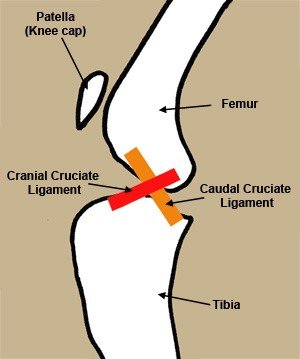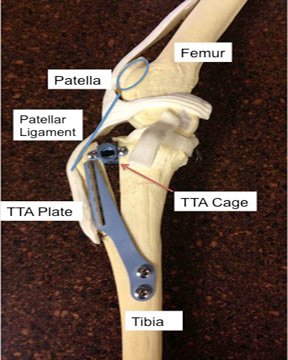An article from WWA’s Doctor’s Orders
 By Dr. K.C. Brooks, an avid waterfowler, dog lover and practicing veterinarian at Lodi Veterinary Care.
By Dr. K.C. Brooks, an avid waterfowler, dog lover and practicing veterinarian at Lodi Veterinary Care.
This article originally appeared in Wisconsin Waterfowl Association’s January 2020 eNewsletter.
One of the most devastating injuries your hunting companion can suffer is a tear of their cranial cruciate ligament. This is especially true if the injury comes during the hunting season or just prior to it. This is the same injury that sidelines many human athletes where the ligament is titled the “anterior cruciate ligament” or ACL. While there are some similarities between the human injury and that of our canine athletes, there are also many differences. This article should help you understand the injury, how it is diagnosed, best treatment options, and what you can do to get a complete recovery for your dog.
 The cranial cruciate ligament is one of the major stabilizers in the canine knee. It, and its counterpart the caudal cruciate, allow the knee to flex, extend and rotate slightly. This allows the canine athlete to run, jump, turn sharply and swim with incredible efficiency. It is believed that cruciate tears in dogs result from a progressive weakening of the ligament. This has been compared to a rope slowly “fraying” and thereby making it increasingly weaker. Some dogs with cruciate disease will have several episodes of waxing and waning lameness before the ligament finally tears completely. Once the ligament ruptures, the dog remains lame to some degree. Left untreated, a cruciate tear results in crippling osteoarthritis and loss of muscle strength in the rear leg.
The cranial cruciate ligament is one of the major stabilizers in the canine knee. It, and its counterpart the caudal cruciate, allow the knee to flex, extend and rotate slightly. This allows the canine athlete to run, jump, turn sharply and swim with incredible efficiency. It is believed that cruciate tears in dogs result from a progressive weakening of the ligament. This has been compared to a rope slowly “fraying” and thereby making it increasingly weaker. Some dogs with cruciate disease will have several episodes of waxing and waning lameness before the ligament finally tears completely. Once the ligament ruptures, the dog remains lame to some degree. Left untreated, a cruciate tear results in crippling osteoarthritis and loss of muscle strength in the rear leg.
Diagnosis of the tear can usually be accomplished with an orthopedic exam and radiographs. Dogs usually require some sedation to allow manipulation of the joint without interference from the large thigh muscles. Specific radiographic views are required to assess your dog’s confirmation which aids your veterinarian in deciding what type of repair is ideal for your dog.
 Surgical correction of the cruciate tear is almost always needed for the canine athlete to return to full function. Fortunately, surgical procedures have progressed to the point that a large percentage of dogs with torn cruciate ligaments can return to their original level of athletic performance. At our hospital, 90-95 percent of dogs that undergo cruciate surgery eventually return to normal athletic performance. Unlike their human counterparts who suffer this injury, dogs are usually sound within 12 weeks of surgery and can often return to performance activity within 5-6 months.
Surgical correction of the cruciate tear is almost always needed for the canine athlete to return to full function. Fortunately, surgical procedures have progressed to the point that a large percentage of dogs with torn cruciate ligaments can return to their original level of athletic performance. At our hospital, 90-95 percent of dogs that undergo cruciate surgery eventually return to normal athletic performance. Unlike their human counterparts who suffer this injury, dogs are usually sound within 12 weeks of surgery and can often return to performance activity within 5-6 months.
Several surgical techniques are available to repair cruciate tears but they essentially fall into one of two categories. One set of techniques, lateral suture & Tightrope, attempt to “mimic” the original cruciate by placing implants outside of the joint capsule in a position parallel to the original cranial cruciate ligament. These techniques work best in smaller dogs with ideal conformation. The second group of repairs is the “osteotomies”. These include the TPLO, TTA and CBLO. These techniques, in essence, make the cranial cruciate ligament unnecessary for complete function of the knee. In general, these techniques seem to allow for a faster recovery and seem to be a better option for larger, athletic dogs. Your veterinary surgeon should be very well versed in the variety of procedures available and should guide you in making the decision about which technique is best for your dog.
Follow up care after surgery, including a rehabilitation plan, is very important for a successful recovery from surgery. In our hospital, dogs are seen at least four times after surgery with three of the four visits dedicated to assessing function and introducing a rehabilitation plan. This plan should be designed to encourage early weight bearing, working toward obtaining complete range of motion and finally, rebuilding strength and proprioception. While specialty equipment like an underwater treadmill can be helpful during recovery, most dogs can successfully return to optimal function utilizing common household objects and a good plan.
A ruptured cruciate ligament is an unwelcome and serious injury that can put your dog’s athletic career at risk. Fortunately, prompt diagnosis, corrective surgery and a good rehabilitation program can have them back in the field in a very reasonable period of time. Enjoy your dog!
